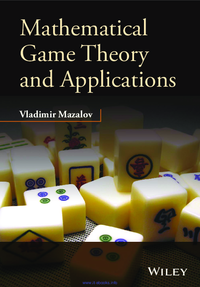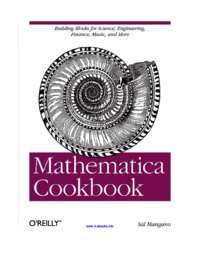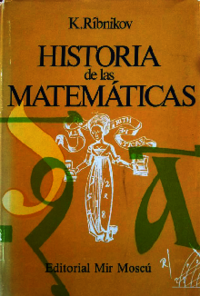Categoría "Matemática"
Se han encontrado 26 Coincidencias
PII: B978-0-444-52087-6.50000-7
concept of distance
73 Visitas | 82 Descargas | 2015-10-29 20:11:23 | mae
The concept of distance is one of the basic ones in the whole of human experience. In everyday life it usually means some degree of closeness between two physical objects or ideas, i.e., length, time interval, gap, rank difference, coolness or remoteness, while the term metric is often used as a standard for a measurement.

Mathematical Game Theory and Applications
Mathematical Game Theory and Applications
117 Visitas | 129 Descargas | 2015-12-17 14:33:54 | pecarrazana
This book offers a combined course of lectures on game theory which the author has delivered for several years in Russian and foreign universities. In addition to classical branches of game theory, our analysis covers modern branches left without consideration in most textbooks on the subject (negotiation models, potential games, parlor games, best choice games, and network games). The fundamentals of mathematical analysis, algebra, and probability theory are the necessary prerequisites for reading. The book can be useful for students specializing in applied mathematics and informatics, as well as economical cybernetics. Moreover, it attracts the mutual interest of mathematicians operating in the field of game theory and experts in the fields of economics, management science, and operations research. Each chapter concludes with a series of exercises intended for better understanding. Some exercises represent open problems for conducting independent investigations. As a matter of fact, stimulation of reader’s research is the main priority of the book. A comprehensive bibliography will guide the audience in an appropriate scientific direction.

Mathematica Cookbook
Wolfram Mathematica
129 Visitas | 110 Descargas | 2016-10-31 15:44:49 | pecarrazana
The Mathematica Cookbook was one of my most challenging projects and it is not something I could have accomplished without the support of many people. Although I would have never survived without this help, any problems, errors, or omissions in the final product are mine alone. Wolfram Mathematica

THE GREEN COMPUTING BOOK
75 Visitas | 60 Descargas | 2017-02-14 06:13:42 | raulito
In 1957, the Soviet Union launched the first Earth-orbiting artificial satellite—Sputnik I—into space. This singular event precipitated the birth of the space age and, more specifically, the U.S.–U.S.S.R. space race. If we fast forward 45 years, the year is 2002, and Japan unveils the first supercomputer that obliterates U.S. domination in supercomputing,?creating such a fervor that the event is dubbed Compute-nik and ignites an “arms race in supercomputing” in which the need for speed is paramount above all else and supercomputing (also referred to as high-performance computing or HPC) becomes increasingly mainstream, as illustrated in Figure 0.1 from the U.S. Council of Competitiveness, and as detailed in a report by the President’s Information Technology Advisory Committee (PITAC). However, this singular focus on speed as a performance metric arguably comes at the expense of other performance metrics, such as efficiency, reliability, and availability, to name a few. These “other” metrics are of particular interest to our Supercomputing in Small Spaces (SSS) project, which started in 2001, when being cool was “not cool.” Why? With the supercomputing community’s focus on speed, supercomputing nodes were not only becoming faster but also consuming and dissipating more power. By applying Arrhenius’s equation† to microelectronics or, more generally, computer hardware, every 10?C increase in temperature doubles the failure rate of a given system. This equation was supported by our own informal empirical data at the time, specifically a 128-node cluster that resided in a warehouse and failed approximately once perweek during thewinter months when the temperature inside the warehouse was 21–23?C and approximately twice per week during the summer months when the temperature was 30–32?C.

Teoría de Grupos, un primer curso
Álgebra
148 Visitas | 69 Descargas | 2018-11-16 19:15:04 | jssalvador
El éxito de la Teoría de Grupos es impresionante y extraordinario. Es quizás, la rama más poderosa e in?uyente de toda la Matemática. In?uye en casi todas las disciplinas cientí?cas, artísticas y en la propia Matemática de una manera fundamental. Lo que realmente se ha hecho en la Teoría de Grupos, es extraer lo esencial de diversas situaciones donde ocurre. Dado un conjunto no vacío, de?nimos una operación binaria en él, tal que cumpla ciertas axiomas, es decir, que posea una estructura, (la estructura de grupo). El concepto de estructura y los relacionados con éste, como el de isomor?smo, juegan un papel decisivo en la Matemática actual.

Historia de las Matemáticas
162 Visitas | 138 Descargas | 2021-10-08 03:43:41 | jac_0204
El objetivo del presente libro es ayudar a los estudiantes de las especialidades de matemáticas de las universidades e institutos pedagógicos así como a amplios círculos de especialistas matemáticos a asimilar desde exposiciones materialistas la experiencia histórica de la ciencia en cuestión, las fuerzas motrices y vías de desarrollo.
Contribuir
Usted puede contribuir con Libros UCLV, es importante para nosotros su aporte..
Contribuir